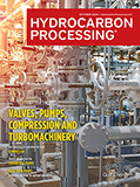Products
Improve refinery production and efficiency with asset monitoring
The sheer volume of equipment in a refinery—from vessels, columns, huge structures and mazes of pipes to pumps, valves, controllers and instruments—is staggering.
Onsite
Jenny Hebert and George Yaluris of Albemarle accept the <i>HP</i> Award for Best Catalyst Technology.
Viewpoint: Reducing the sulfur shadow— Who pays the price?
The International Maritime Organization’s (IMO’s) 2020 regulation has been described as the most disruptive change to impact the oil industry in the past 30 yr.
Editorial Comment: The reemergence of a collaborative platform
Readers have witnessed that throughout the life of the publication, <i>Hydrocarbon Processing</i> has always published information on new technologies to increase efficiency, safety and profitability in downstream processing operations, while introducing techniques to decrease environmental footprint and emissions and produce high-quality, clean fuels and petroleum products for consumers around the world.
Process safety as a profit center?
In today’s economic environment, new capital spending is harder to find than loose change buried under the couch cushions.
Hydrocarbon Processing Awards
<i>Hydrocarbon Processing,</i> the downstream processing sector’s leading technical publication, has announced the winners for its second annual awards.
Technical considerations for the Heydar Aliyev refinery revamp
The following case study describes the early development phases of SOCAR’s ongoing major revamp project at the Heydar Aliyev Refinery (HAR) in Baku, Azerbaijan, and its interface with the associated Azerikimya (AZK) steam cracking complex near Sumgait. References are made to the related SOCAR polymer project in Sumgayit, as well.
Additive solutions to SOx emissions in FCCUs
Sulfur oxide additives are typically based on hydrotalcite or magnesium aluminate spinel-type structures. Magnesium alumina is the pickup agent present in the most effective SO<sub>x</sub> additives on the market; therefore, to optimize SO<sub>x</sub> reduction, it is critical to maximize the amount of the critical magnesium component in the fluid catalytic cracking unit (FCCU) in an efficient and cost-effective way.
Business Trends: A strategic energy solution
Refining is the process of separating crude oil into different hydrocarbon groups through distillation.
Industry Perspectives: The latest advancements in refining/petrochemical technologies on display
From September 25–26, Hydrocarbon Processing will bring its International Refining and Petrochemical Conference (IRPC) back to the US.

- KBR to provide technology for mega-scale ammonia plant in Angola 11/25
- Indian refiners' October crude processing up over 3% y/y 11/25
- Air Liquide strengthens partnership with TotalEnergies through renewable H2 project in France 11/25
- Hexagon collaborates with Microsoft to enhance industrial operations 11/25
- China issues extra crude oil import quota to teapot refineries 11/25
- McDermott achieves ISO 50001 Certification for energy management at four fabrication yards 11/25




